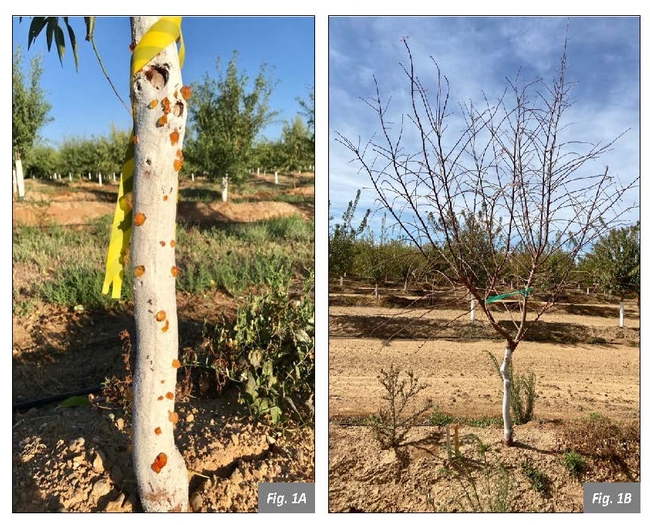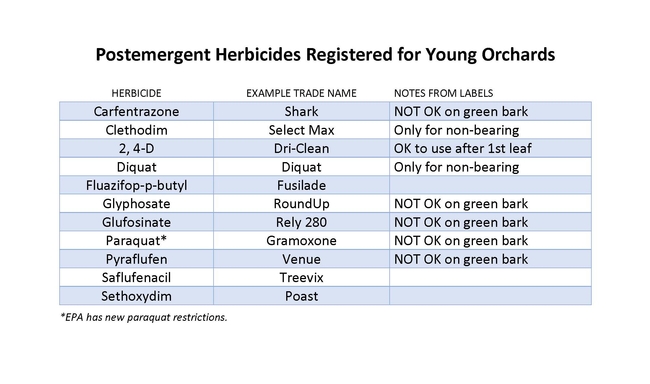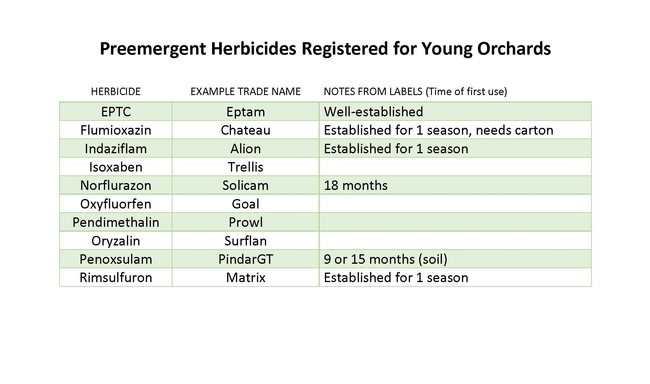Weeds in young orchards compete with trees for orchard resources such as sunlight, water and nutrients. This can lead to reductions in growth and future yields. If weed stands are allowed to mature, not only are they harder to control via chemical and mechanical methods, but they can also create cover for voles and gophers which can then damage tree trunks, root systems and irrigation systems.
Weed management can be particularly difficult in newly planted and young orchards because rapid weed growth is accelerated by frequent irrigation necessary to establish trees, fertilizer inputs to grow the trees, and the abundant sunshine due to small tree size. In addition, control is challenging because tree trunks may still be green and sensitive to contact and systemic herbicides, which can cause severe trunk damage and canopy stress. For these reasons, weed control can be one of the most obstructive facets of establishing a new orchard. While weeds are present in every orchard, there is variation in the weed species composition and density from orchard to orchard especially in young orchards. Scouting for weeds is the basis for a good Integrated Weed Management (IWM) plan. Postharvest scouting should start early and be repeated once more before the start of the season in order to catch weeds when they are young. Herbicide applications targeting mature weeds are often minimally effective, resulting in a less successful program and increased management costs.
Postemergent materials are often used for control of weeds in newly planted trees. Contact products (AKA burndown herbicides) kill the leaves and green stems of plants that they come in contact with. Systemic herbicides enter the plant and move to the actively growing tips of the plants they come in contact with. Postemergent herbicides require repeated treatment to control weeds throughout the season and careful timing of these short-lived products is necessary to control weeds in young orchards. Caution should be used when applying either form of postemergent materials, because drift or direct spraying onto leaves or green tree trunks can lead to damage or even kill young trees (see Figure 1). Crop safety is usually achieved by prudent application, being extra cautious with windy conditions, spray rig height, nozzle angles, and nozzle selection.
A proactive yet often overlooked method to manage weeds in young orchards is the application of preemergent products. Preemergent herbicides control weed seedlings as they germinate halting the development of seedling shoots and roots, ultimately preventing emergence. These herbicides can provide residual control throughout the year if properly timed and applied. Applications can be made once in the winter or early spring going into summer and again in the fall to target warm and cool season species, respectively. Preemergents bind to organic matter and soil to limit leaching and mobility once applied to provide residual control. Clearing berms of leaf litter and skeletal remains of any resident vegetation from last season will help evenly distribute and incorporate the pre-emergent for optimal control. The majority of these products require between 0.25-0.75 inches of rain/irrigation for proper incorporation and effectiveness. Plantings that were made in fall can take advantage of winter and spring rains.
CAUTIONARY NOTE
Many growers rely heavily on a single herbicide program on an annual basis. This might be because of affordability or the initial effectiveness of the program. However, by using the same products and mode of action to kill weeds, we are selecting for herbicide resistance. With the growing number of herbicide-resistant weeds in California orchards, control of escaped (resistant) weeds can considerably reduce the long-term cost of an annual orchard floor management program. For example, spot treating two acres of glyphosate-resistant palmer amaranth with a tank mix of glufosinate and paraquat is much more affordable than trying to control it over an entire 40-acre block. Remember to scout this winter so you can spot treat, rather than having an orchard full of herbicide-resistant weeds in the future.
For more information regarding the status of herbicide resistance in California see The Current Status of Herbicide Resistance in California by Lynn Sosnoskie.
And for more information regarding young orchard management, visit the Sacramento Valley Orchard Source: Weed Management For Young Orchards by and Brad Hanson.
Drew Wolter is a graduate student in the Hanson Lab (Weed Science Program, Dept. of Plant Sciences) at UC Davis.


